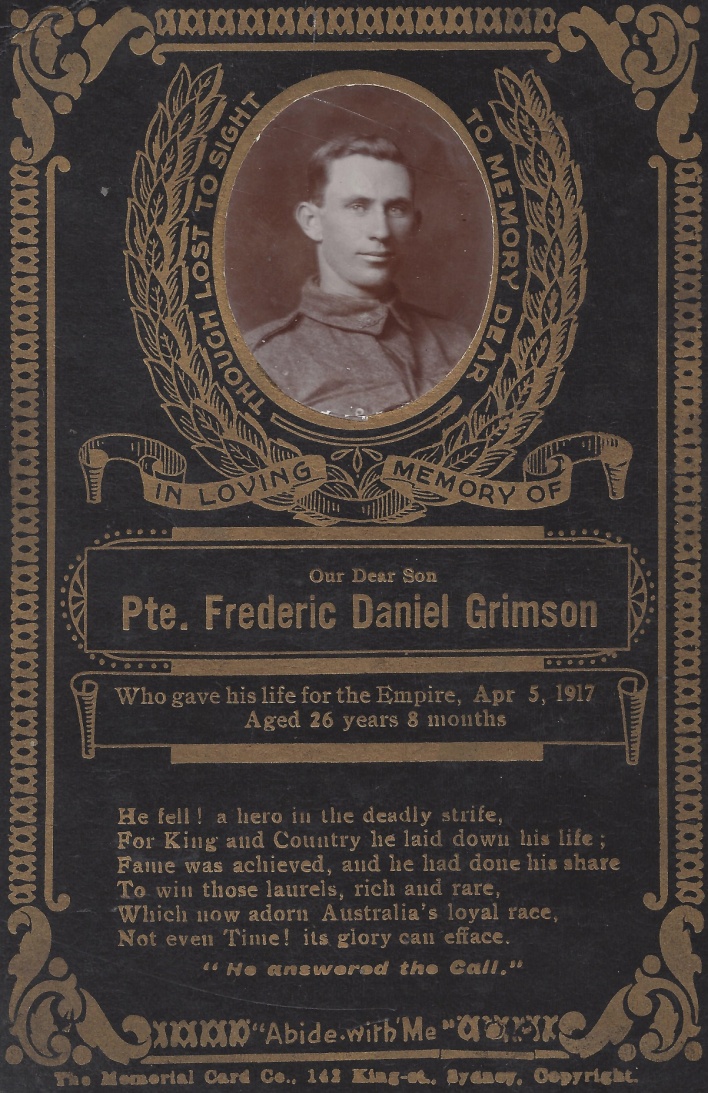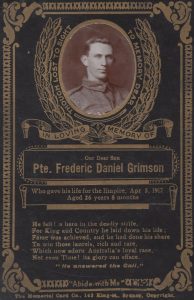Frederick Daniel Grimson was born near Cumnock in 1890, the son of Edmund and Mary Ann Grimson. Their children were Charles (born 1876), Lydia (born 1878), Stephen (born 1880), Edmond (born 1884), Robert (born 1887), and Frederick.
The Grimson family in Cumnock originated from Stephen and Lydia (nee Brown) Grimson, from Norfolk, England. They had eight children – Stephen (born 1827), Robert (born 1828), Charles (born 1830), Samuel (born 1832), James (born 1833), Rachel (born 1835), Lydia (born 1838) and John (born 1840).
Stephen Grimson and his 24 year old son, Stephen, worked as agricultural labourers when the 1851 England Census for Norfolk/Toft Monks was recorded. In 1852 Stephen Grimson (Jnr) married Sarah Simmons in the county of Norfolk. They had one child, Edmond Grimson, born in 1853, in Norfolk. Sarah Grimson died in 1855.
Stephen Grimson, aged 29 years, along with his 3 year old old son, Edmund, were Assisted Immigrant Passengers on the ship Lloyds, arriving at Sydney on 4 September 1856. He stated on the ship’s papers that his brother Samuel was living at Newtown. Samuel, aged 21 years, had arrived in Australia on 21 October 1854, on the Anglo Saxon. Another brother, Robert, also came to Australia, around the same time as Samuel and Stephen. The three Grimson brothers started the St Peter’s (Sydney) brickworks. Stephen later purchased horse teams and in about 1872, started carrying trade between Sydney and Bourke. His son Edmund accompanied him with a second team. Leaving the road, father and son settled on land on Yullundry Creek, near Cumnock. Robert eventually settled in Wellington, and Samuel at Crookwell, – both married with children.
Stephen Grimson married Mary Ann Townsend at Molong in 1876, and they had five children. An unnamed son (born and died 1877), a daughter (born 1879), Mary (born and died 1881), Robert (born 1883 died 1887), and Samuel (born and died 1886).
In 1893 Stephen Grimson bought 320 acres of land along Yullundry Creek which he called Norfolk Farm, in the parish of Buckinbah, county of Gordon, and a further 40 acres in 1896. They grazed sheep and farmed wheat, and won several competitions at local shows. Mary Ann Grimson died, aged 54 years, on 17 September 1898, at Yullundry Creek. Stephen Grimson sold his Yullundry farm in 1904 and died, aged 85 years, on 3 September 1912. The couple are buried in the Anglican portion of the Cumnock Cemetery.
Edmund (variously spelt as Edmond or Edward) took up a selection adjoining his father’s, at Yullundry. In 1918 Edmund Grimson was reported in local newspapers as having built new sale yards, held a license to run billiards in Cumnock, and was the local news agent – stocking pipes, tobacco, fancy goods, phonographs and other articles. He was a member of the Cumnock Club and took an active part in community activities. Edmund Grimson died aged 67 years at his Yullundry farm, on 8 February 1921, having lived there for 47 years. The farm was managed by his son, Robert, in later years. Mary Ann Grimson moved to Orange to live in 1922. She died aged 95 years, in 1949, at Kiama.
Frederick or ‘Ned’ Grimson would have attended Yullundry School and enjoyed playing tennis and playing the violin. He played the violin for many social occasions in Cumnock and Yeoval and was a member of the Cumnock Brass Band. He worked for a time a time for Mr Arthur Job but also had his own farm at Bellview, Yullundry Creek.
Frederick enlisted in the AIF at Cumnock on 13 April 1916, aged 25 years and 8 months, and was examined by the town GP, Dr Ivie Aird. He was 5 feet 10 inches tall, had fair complexion hair, blue eyes, and was of the Church of England religious denomination.
The Molong Express and Western District Advertiser, 4 November 1916, p. 4, reported on a Yullundry Soldier Farewelled:
One of the largest crowds ever known at Yullundry gathered at ‘Fairview,’ the residence of Mr and Mrs A Job on Tuesday October 24, to bid farewell to one of the most highly esteemed and respected young residents, Pte F D Grimson, who has answered the Empire’s call and who was expected to sail last Tuesday, to join his comrades who are fighting the great battle for freedom and justice, and for King and country. Private Grimson is a native of Yullundry, where his respected parents (Mr and Mrs Edmond Grimson) still reside. He is also a brother of that gallant soldier, Corporal C Grimson, DCM.
Private Grimson was motored with his father and mother to the send-off party at about four o’clock by Mr A Job. About 300 people were gathered to meet him, and, judging by the good wishes that were bestowed on him, there is not the least doubt that he is greatly respected in the Yullundry district, and we feel sure that if the opportunity arises he will make a name for himself and the district.
Games of all descriptions were indulged in till tea time, which commenced at 6.30 in a large wheat shed, decorated tastily with flags. Mr WR Glasson, of Brigalow, in a nicely spoken and interesting speech, presented Pte Grimson, on behalf of the residents of Yullundry, with a handsome wristlet watch and solid silver n safety razor. Mr JD Morris, in a well-chosen speech, presented the guest, on behalf of the residents of Bournewood, with a beautiful pocket wallet and fountain pen. Private Grimson suitably replied, and expressed his grateful thanks for the kindness of the district people for the presents, and for the good wishes that had been bestowed on him.
The floor was then cleared for dancing, and about 50 couples graced the floor. The music was supplied by Miss Whittaker, and Messrs Wykes, Grimson, and Martin, on violin and concertina. At midnight, supper was partaken of, and dancing was resumed, and continued till late. Messrs D and H Wykes and T Brown were the MCs.
Private Grimson, accompanied by most of the members of the Grimson family, was conveyed to Molong on Thursday evening by Messrs A and R Job, in their two cars, to catch the mail train for Sydney.
Private Frederick Grimson embarked from Sydney on 30 October 1916 on HMAT Argyllshire A8. The Argyllshire arrived at Plymouth on 10 January 1917 and he proceeded to the Training Battalion at Larkhill. He travelled to France on 28 March and joined the 23rd Battalion on 1 April 1917. Just four days later he died suddenly.
A friend, Miss Mary O Hunter, of Three Rivers, via Molong, wrote to the War Office saying that she had received a letter from Private Grimson dated 2 April, in which said he was in the best of health.
An official letter was sent to Private Grimson’s parents by his Commanding Officer on 27 June 1917, stating:
Pte Grimson died of unknown causes in the early hours of the morning of 5 April 1917. He had complained of not feeling well the previous evening, but did not think it serious enough to see the Medical Officer. At about midnight on 4 April he fell down unconscious on leaving the hut. The Medical Officer was immediately called, but Pte Grimson did not recover consciousness and died within 10 minutes. A post-mortem held at the 6th Australian Field Ambulance did not reveal the cause of death. Pte Grimson had only joined the Battalion 2 days prior to his death. Would you kindly convey to the family of the deceased soldier the deepest sympathy of the Officers and men of the 23rd Battalion.
Frederick’s effects were sent to his parents; they included cards, a testament, booklet, pipe, handkerchiefs, scarf, brush and air cushion.
A sale was held at Bellview, Yullundry Creek, for Frederick Grimson’s estate, on 7 November 1917, with a number of draught horses and a quantity of farming machinery offered for sale.
The Molong Argus of 11 July 1919, p. 4, reported:
Recently the residents of Yullundry presented the parents of the late Pte FD Grimson with a silver shield mounted on Australian maple, in memory of their son, who enlisted in 1916, and died of illness in 1917.
Frederick Daniel Grimson is commemorated on Cumnock War Memorial Gates and on panel number 99 on the Roll of Honour at the Australian War Memorial in Canberra. The WE Agland RSL MBE Memorial Museum in Orange contains a memorial plaque in Frederick’s honour.
Frederick’s brother, Charles Grimson, also served in WWI; he returned to Australia from Gallipoli, wounded, in November 1915. He had won the Distinguished Conduct Medal (DCM) for his bravery at Gallipoli and was commended in the Molong, Cumnock and Yeoval districts on his return.
* Peter Tremain, Dianne Strahan and Val McKenzie, August 2016
Cumnock NSW War Memorials


